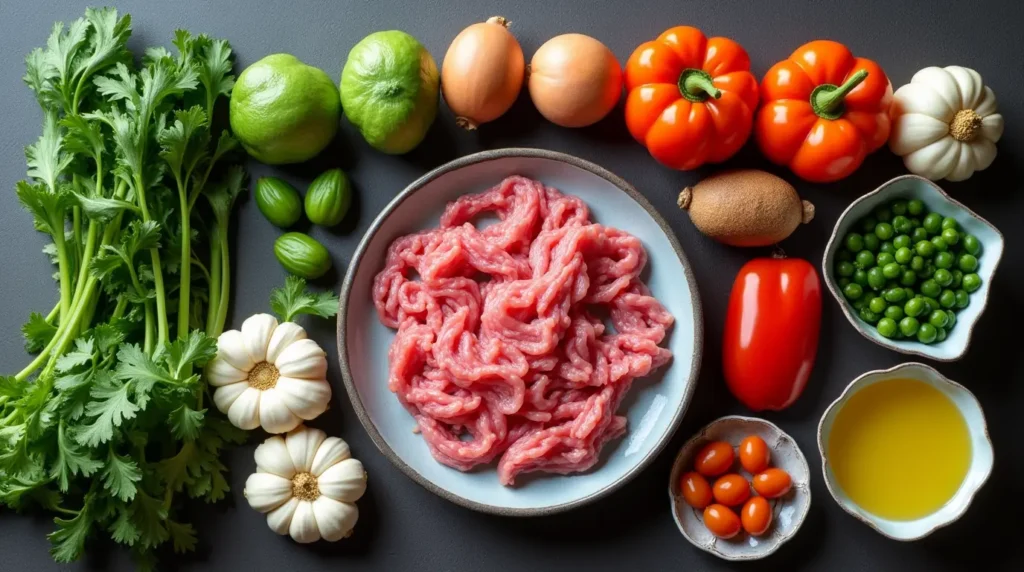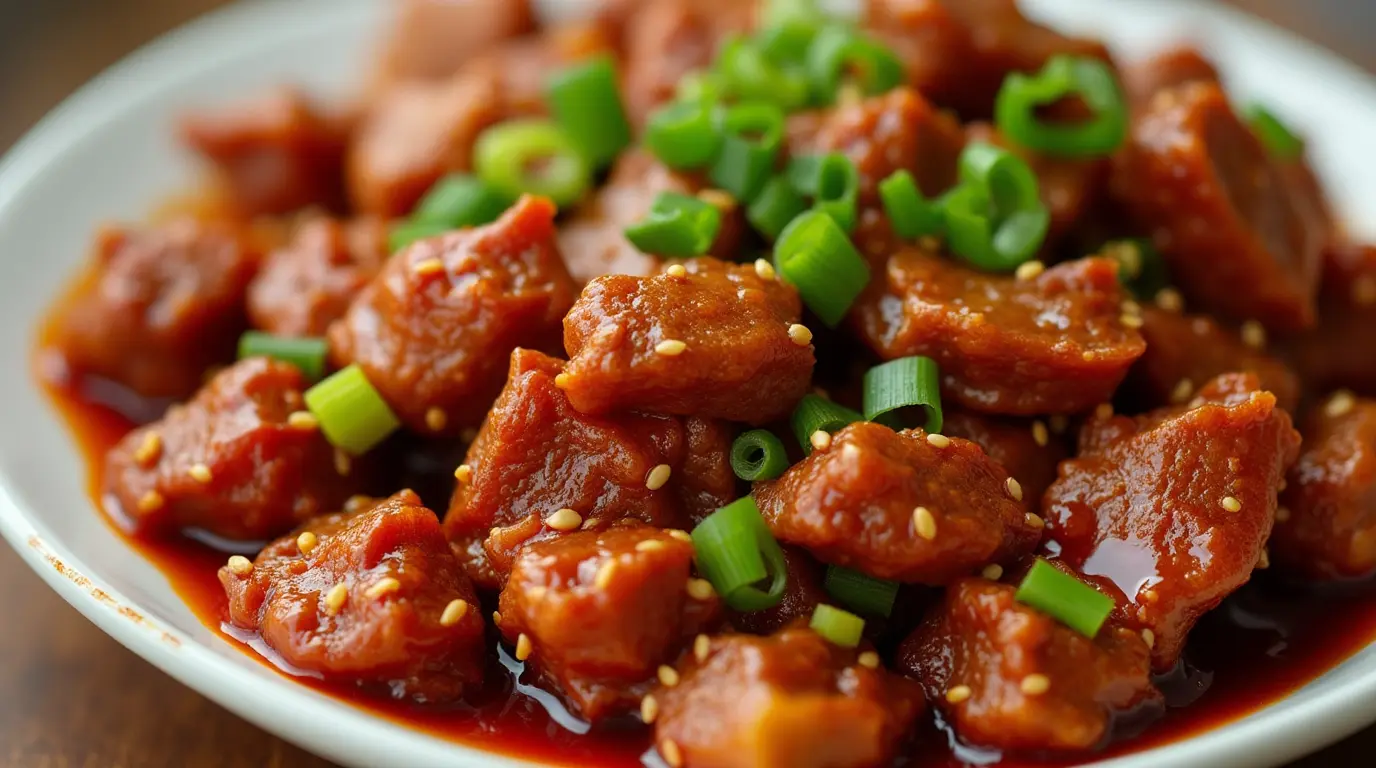Crispy, sticky, and sweet with a kick, Beijing beef is the ultimate Chinese-American comfort food.
This homemade version brings the same bold flavor and addictive sauce you love, but without the takeout wait. It’s fast, family-friendly, and seriously satisfying.
Table of contents
Ingredients for Authentic Beijing Beef
One of the secrets to mastering Beijing Beef is starting with the right ingredients. Let’s break it down into categories.

Essential Components of the Sauce
The sauce is the soul of Beijing Beef. Here’s what you’ll need:
- Soy sauce: For that umami punch.
- Sugar: To add sweetness and balance.
- Vinegar: Typically rice vinegar, for a hint of tang.
- Ketchup: Yes, ketchup! It gives the sauce its signature color and a touch of acidity.
- Garlic and ginger: To layer in depth and warmth.
- Cornstarch slurry: For thickening the sauce to that luscious consistency.
Key Ingredients for the Beef
For the beef, it’s all about choosing the right cut and preparation. Here’s what you’ll need:
- Beef: Flank steak or sirloin works best. These cuts are tender, absorb flavors beautifully, and cook quickly.
- Cornstarch and flour: For creating that irresistible crispy coating.
- Eggs: To bind the flour and cornstarch to the beef strips.
- Vegetable oil: For deep frying.
Substitutions and Alternatives
Don’t worry if you don’t have all the ingredients on hand! Here are some swaps:
- Soy sauce can be replaced with tamari for a gluten-free option.
- Ketchup can be substituted with tomato paste and a splash of honey.
- For a lighter version, skip deep frying and opt for stir-frying with a light coating of oil.
“Cooking is like jazz don’t be afraid to improvise and make the recipe your own!”
Step-by-Step Instructions to Make Beijing Beef
Preparing the Beef for Cooking
The first step in achieving crispy perfection is prepping the beef.
- Slice your beef thinly across the grain to ensure tenderness.
- In a bowl, whisk together eggs, cornstarch, and flour. This creates the batter that gives the beef its signature crunch.
- Dip each beef strip into the batter, ensuring it’s evenly coated.
Crafting the Perfect Sauce
While the beef is marinating, let’s focus on the sauce:
- In a small bowl, mix soy sauce, sugar, vinegar, ketchup, and a cornstarch slurry.
- Heat a wok or large pan over medium heat, add garlic and ginger, and sauté until fragrant.
- Pour in the sauce mixture, stirring continuously until it thickens to a glossy consistency.
Want to go deeper on the flavor base? Check out our dedicated Beijing Beef Sauce guide for variations, storage tips, and expert tweaks.
Cooking and Combining the Ingredients
Finally, it’s time to bring everything together!
- Heat oil in a deep pan or wok until it reaches frying temperature (around 350°F).
- Fry the beef strips in small batches to keep the oil hot and the beef crispy.
- Once all the beef is fried, toss it into the wok with the sauce. Stir well until every piece is coated in that delicious glaze.
“Good food takes time, but the reward is always worth it. Patience is key!”
Tips for Perfecting Your Beijing Beef
Cooking Beijing Beef at home can be a fun and rewarding experience, but it also comes with challenges. Here are some expert tips to make sure your dish is as close to restaurant-quality as possible.
How to Achieve the Right Texture and Flavor
- Marinate the Beef Properly: Even a short marinade of 20–30 minutes can make a big difference in tenderizing the meat and infusing it with flavor. Use soy sauce, a pinch of baking soda, and a splash of rice wine for best results.
- Double Fry for Extra Crispiness: After frying the beef once, let it rest for a few minutes. Then, fry it again at a slightly higher temperature for that perfect crunch.
- Balance the Sauce Flavors: Taste your sauce before tossing the beef in. Add sugar if it’s too tangy or a splash of vinegar if it’s overly sweet. Remember, a good sauce is all about harmony.
Need more ideas like this? Our quick & easy recipes are full of smart shortcuts for bold flavors without the hassle.
Common Mistakes and How to Avoid Them
- Mistake: Overcrowding the Pan During Frying
- Solution: Fry in small batches to maintain the oil’s temperature and ensure each piece of beef crisps up beautifully.
- Mistake: Skipping the Cornstarch Slurry in the Sauce
- Solution: Always add a cornstarch slurry to your sauce for that signature glossy, thick consistency.
- Mistake: Using Low-Quality Beef Cuts
- Solution: Stick to tender cuts like flank steak or sirloin for the best texture and flavor.
Enhancements and Garnishing Ideas
- Add Some Heat: Stir in red chili flakes or diced fresh chilies for a spicier kick.
- Garnish Like a Pro: Top your Beijing Beef with sesame seeds and freshly chopped scallions. Not only does this add flavor, but it also gives the dish a polished look.
- Incorporate Vegetables: Throw in bell peppers and onions for added crunch and color. They pair wonderfully with the sauce!
“Cooking is an art; a sprinkle of creativity can elevate a good dish to greatness.”
Serving Suggestions for Beijing Beef
Pairing your Beijing Beef with the right sides and presentation can take the dish to the next level. Here’s how you can serve it to wow your taste buds and impress your guests.
Ideal Pairings: Sides and Beverages
- Rice is a Classic: Steamed jasmine rice is the go-to pairing for Beijing Beef. The fluffy, neutral flavor balances out the dish’s bold sauce. If you’re feeling adventurous, try fried rice for an extra punch.
- Noodles for the Win: Stir-fried noodles, especially chow mein, complement the crispy beef beautifully. The chewy texture of the noodles contrasts perfectly with the crunch of the beef.
- Vegetable Stir-Fry: Toss together a quick stir-fry with broccoli, snap peas, and carrots. The fresh, crisp veggies add a refreshing balance to the rich flavors of Beijing Beef.
- Beverages: Pair the dish with a light drink like iced green tea or a crisp, cold beer. For non-alcoholic options, a fizzy lemon soda works wonders.
“The secret to a perfect meal? Pairing bold dishes with light sides to let each element shine.”
Presentation Tips for a Restaurant-Style Look
Want to make your Beijing Beef look like it was plated by a professional chef? Here are a few tricks:
- Use a Shallow Platter: Spread the beef in an even layer for better presentation.
- Garnish with a Pop of Color: Sprinkle sesame seeds and finely chopped scallions over the top for a visually appealing finish. You could even add a few thinly sliced red chilies for a splash of red.
- Serve Family Style: Place the dish in the center of the table with sides surrounding it. The communal vibe makes the meal more enjoyable.
Craving more comfort food with a homey touch? Browse our Grandma’s Recipes for more family-style favorites.
Frequently Asked Questions About Beijing Beef
Can I use chicken instead of beef for this recipe?
Yes. You can swap beef for thin-sliced chicken breast or thighs. The sauce works just as well, and it cooks even faster.
What oil is best for frying the beef?
Use a neutral, high-smoke-point oil like vegetable, canola, or peanut oil. Avoid olive oil, as it burns quickly at high heat.
How can I make this recipe gluten-free?
Use tamari instead of soy sauce and replace regular flour or cornstarch with a gluten-free starch like arrowroot or rice flour.
Is Beijing beef originally from China?
No. Beijing beef is a Chinese-American invention popularized by restaurants like Panda Express. It’s inspired by Chinese flavors but tailored to Western tastes

